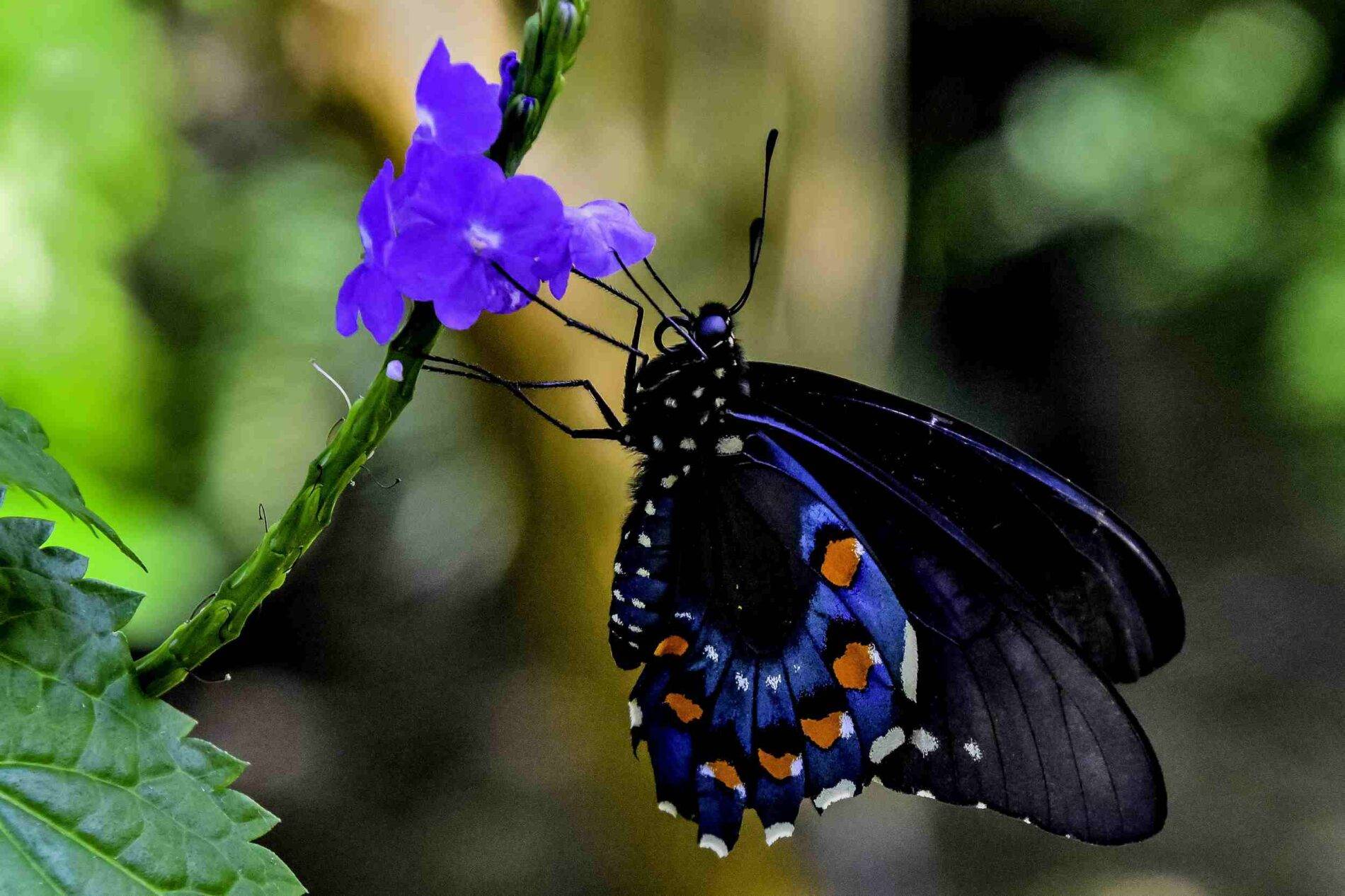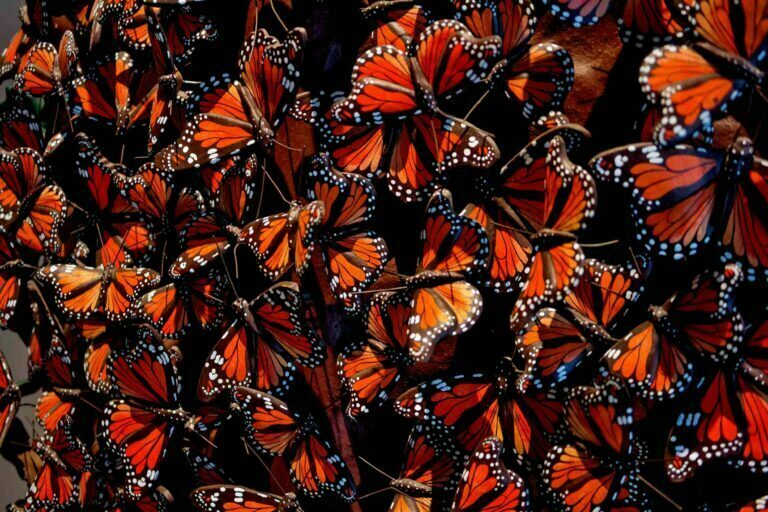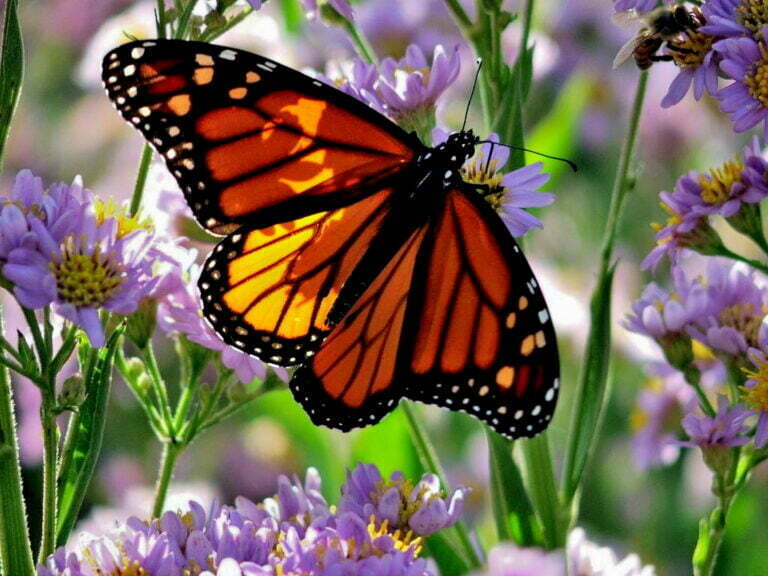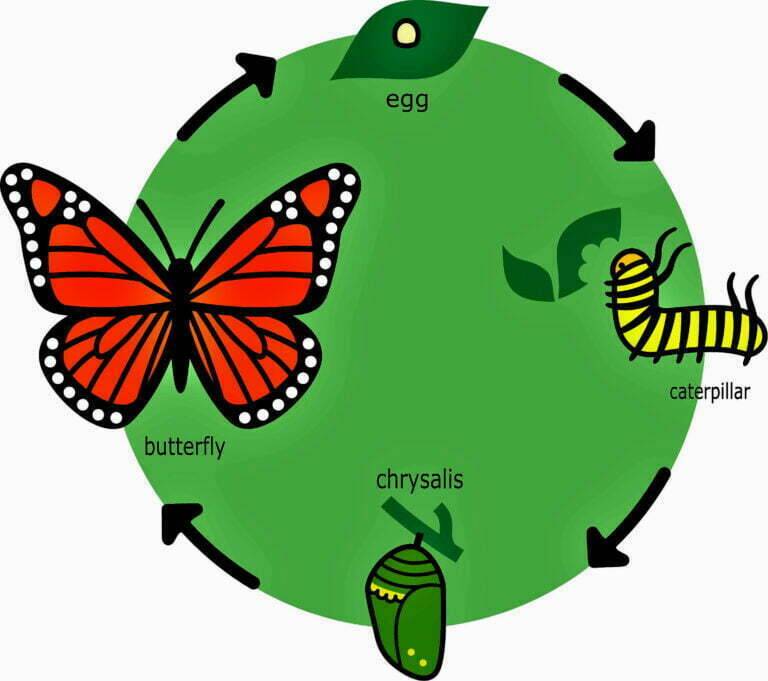Butterflies, belonging to the order Rhopalocera, are insects characterized by large, often brightly colored wings and a distinctive, fluttering flight. The origins of butterflies date back to the Paleocene, approximately 56 million years ago, with some suggestions that they may have emerged even earlier. These creatures undergo a four-stage life cycle, exhibiting complete metamorphosis, a characteristic feature shared with other “holometabolan” insects.
The life cycle comprises winged adults laying eggs on host plants, where the larvae, known as caterpillars, feed. As the caterpillars grow, often at a rapid pace, they eventually pupate within a chrysalis. Upon completing metamorphosis, the adult emerges from the pupal skin, expands its wings, dries them, and takes flight.
Types of Butterflies with Names
The life cycle duration varies among butterfly species. Some, particularly in tropical regions, may undergo several generations within a year, whereas others, especially in colder climates, might take several years to complete their entire life cycle. Butterfly populations exhibit polymorphism, utilizing camouflage, mimicry, and aposematism as strategies to avoid predators.
Noteworthy species like the monarch and painted lady engage in long-distance migrations. Butterflies are not exempt from natural threats, facing parasites such as wasps, protozoans, flies, and other invertebrates, as well as predation by various organisms. Certain species, in their larval stages, pose as pests, causing damage to domestic crops or trees, while others play a crucial role in pollinating specific plants. Some butterfly larvae contribute to pest control by preying on harmful insects, and a few establish mutualistic relationships with ants.
Different Types of Butterflies with Names
Beyond their biological significance, butterflies hold cultural prominence, frequently serving as popular motifs in the visual and literary arts. Their vibrant and delicate beauty has captured human fascination, making them subjects of inspiration and creativity across various cultural expressions. Here are 10 different types of butterflies with names:
Peacock Butterfly (Aglais io)
The Peacock Butterfly, scientifically known as Aglais io, is a medium-sized butterfly renowned for its captivating appearance. With a wingspan ranging from 2 to 2.5 inches (50 to 65 mm), it features velvety upper wings adorned with striking eyespots resembling a peacock’s tail. The vibrant colors include deep reds, browns, and blacks, creating an intricate pattern that dazzles observers. When at rest, the underside of its wings reveals a mottled and camouflaged appearance, aiding in blending into its surroundings.
In terms of habitat, the peacock butterfly showcases adaptability, thriving in diverse environments. It is commonly found in meadows, grasslands, and fields rich in nectar-producing flowers. Woodlands and forest edges also serve as suitable habitats, demonstrating its versatility. During the winter, these butterflies seek refuge in tree hollows or buildings, entering a state of hibernation to conserve energy. Native to Europe and temperate Asia, including the United Kingdom, mainland Europe, China, and Japan, the peacock butterfly has also been introduced to other regions, including North America.
Swallowtail Butterfly (Papilio machaon)
The Swallowtail Butterfly (Papilio machaon) is a large and graceful butterfly recognized for its distinctive swallowtail-shaped hindwings. With an impressive wingspan ranging from 2.4 to 3.3 inches (60 to 85 mm), it displays a striking combination of yellow, black, and blue markings. The hindwings often feature a series of red or blue eyespots, adding to their allure. Swallowtails are known for their erratic flight patterns and agile maneuvers.
Inhabiting a variety of environments, swallowtail butterflies are often found in meadows, gardens, and open fields where their primary larval host plants, such as parsley and dill, thrive. The larvae of swallowtails are remarkable caterpillars, often resembling bird droppings as a form of camouflage. The Swallowtail Butterfly is distributed across different continents, including Europe, Asia, North America, and Africa, with various subspecies adapted to local conditions.
Painted Lady Butterfly (Vanessa cardui)
The Painted Lady Butterfly (Vanessa cardui) is a widespread and migratory species known for its remarkable annual migrations. With a wingspan ranging from 2 to 2.9 inches (50 to 75 mm), it features distinctive orange-brown wings adorned with black and white spots. The undersides of the wings are more muted, providing effective camouflage when at rest.
Painted lady butterflies are highly adaptable and can be found in a wide range of habitats, including meadows, gardens, and open landscapes. They are known for their extensive migrations, covering thousands of miles across continents. The larvae feed on various host plants, including thistles, mallows, and sunflowers. Painted lady butterflies are found on almost every continent, showcasing their ability to thrive in diverse climates.
Blue Morpho Butterfly (Morpho menelaus)
The Blue Morpho Butterfly (Morpho menelaus) is an enchanting species celebrated for its vibrant and iridescent blue wings. With a wingspan of around 5 to 8 inches (127 to 200 mm), it is one of the largest butterflies in the world. The dazzling blue color is not a result of pigmentation but rather of the microscopic scales on its wings refracting light. This phenomenon creates a mesmerizing display, especially when in flight.
Native to the rainforests of Central and South America, including countries like Brazil, Peru, and Ecuador, the Blue Morpho prefers habitats with lush vegetation and high humidity. The undersides of its wings are brown and serve as effective camouflage when the butterfly is at rest. Blue Morpho Butterflies are often found near water sources, and they have a distinctive, swift flight pattern, making them a highlight in their tropical habitats.
Red Admiral Butterfly (Vanessa atalanta)
The Red Admiral Butterfly (Vanessa atalanta) is a striking species characterized by its black wings adorned with orange-red bands and white spots. With a wingspan of approximately 1.8 to 2.7 inches (45 to 70 mm), it is a medium-sized butterfly known for its distinctive coloration and rapid flight. The Red Admiral has a strong and steady flight pattern, making it easily recognizable.
Red Admiral Butterflies inhabit a variety of environments, including gardens, meadows, and woodlands. They have a wide distribution and are found in North America, Europe, Asia, and North Africa. The larvae feed on nettles, and the adults are often seen nectaring on flowers. The migratory behavior of the Red Admiral contributes to its widespread presence across different regions, showcasing its adaptability to diverse climates.
Black Swallowtail Butterfly (Papilio polyxenes)
The Black Swallowtail Butterfly, scientifically known as Papilio polyxenes, is a captivating species native to North America. Recognized for its striking appearance, it features a wingspan ranging from 2.75 to 4 inches (70 to 100 mm). The upper side of its wings is predominantly black, accented with elegant rows of yellow spots and a distinct iridescent blue band. A characteristic feature is the tails extending from its hindwings, contributing to its name.
This butterfly is versatile in its habitat preferences; it is commonly found in open fields, meadows, gardens, and woodland edges. Its larvae, often referred to as parsley worms or swallowtail caterpillars, feed on host plants such as parsley, dill, and fennel. The Black Swallowtail is a nectar lover, frequently visiting flowering plants like milkweed, thistles, and coneflowers. Its widespread distribution across North America highlights its adaptability to various ecological niches.
Common Jezebel Butterfly (Delias eucharis)
The Common Jezebel Butterfly (Delias eucharis) is a vibrant and widespread butterfly native to Southeast Asia. With a wingspan averaging around 2.5 inches (63 mm), it showcases a delightful combination of colors. The upper side of its wings is characterized by a striking pattern of black, red, and white, creating a visually stunning display. The females often have broader wings than the males.
This species is commonly found in a range of habitats, including gardens, forests, and open woodlands. Its adaptability allows it to thrive in both urban and natural environments. The common jezebel has a distinct flight pattern, fluttering gently among flowers to feed on nectar. The larvae of this butterfly typically feed on plants belonging to the family Capparaceae, highlighting its ecological role in maintaining a balance in plant-insect interactions.
Eastern Tailed-Blue Butterfly (Cupido comyntas)
The Eastern Tailed-Blue Butterfly (Cupido comyntas) is a small and charming butterfly native to North America. With a wingspan ranging from 0.75 to 1.25 inches (19 to 32 mm), it is one of the smallest butterflies in the region. The upper side of its wings is adorned with subtle shades of blue, while the undersides feature intricate patterns and a distinctive pair of tails on the hindwings.
This butterfly is commonly found in open habitats such as meadows, fields, and grassy areas. It has a close association with leguminous plants, particularly those in the pea family, where its larvae feed. The Eastern Tailed Blue exhibits a rapid and erratic flight pattern, making it a delightful sight in sunny, open spaces. Its small size and intricate markings contribute to its overall charm.
Zebra Longwing Butterfly (Heliconius charithonia)
The Zebra Longwing Butterfly (Heliconius charithonia) is a distinctive and tropical species found in the Americas, ranging from the southern United States to South America. With a wingspan of approximately 3 to 4 inches (76 to 102 mm), it boasts elongated wings featuring bold black and yellow stripes, resembling the pattern of a zebra.
Native to tropical and subtropical habitats, the Zebra Longwing is often found in rainforests, gardens, and wooded areas. Unlike many butterflies, it is known for its relatively long lifespan, and it has a unique feeding behavior. This butterfly primarily feeds on nectar but also supplements its diet with pollen. It has the ability to digest pollen, which contributes to its extended lifespan compared to other butterfly species.
Cabbage White Butterfly (Pieris rapae)
The Cabbage White Butterfly (Pieris rapae) is a small to medium-sized butterfly that has spread across several continents. With a wingspan of about 1.5 to 2.75 inches (38 to 70 mm), it has white wings with black markings, often resembling the patterns found on cabbage leaves. The males and females are similar in appearance.
Adaptable and resilient, the Cabbage White Butterfly is commonly found in various open habitats, including gardens, meadows, and agricultural fields. Its larvae, often referred to as cabbage worms, are known for their feeding on plants from the cabbage family (Brassicaceae), which includes crops like cabbage, broccoli, and mustard. While considered a pest in some agricultural settings, the Cabbage White is a fascinating species that showcases the intricate relationship between butterflies and their host plants.



